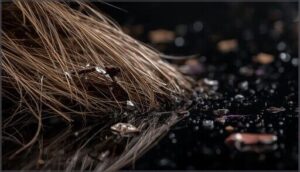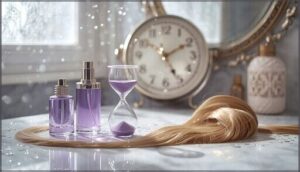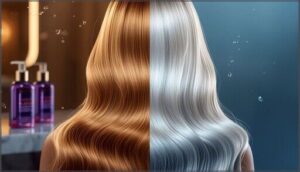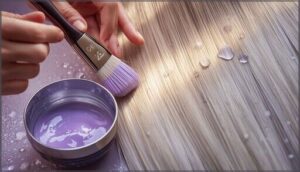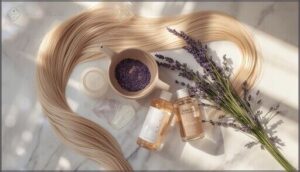This site is supported by our readers. We may earn a commission, at no cost to you, if you purchase through links.
You’ve toned your hair once, but the brassy warmth is still peeking through. The temptation to grab that toner bottle and go for round two is strong—after all, wouldn’t a second pass finally get you that cool, silvery blonde you’re after?
Here’s the truth: you can tone your hair twice, but it’s not always the smartest move. Each toning session adds chemical stress to your strands, and doubling up can push your hair past its breaking point.
The difference between achieving your dream shade and ending up with dry, fragile hair often comes down to timing and technique. Understanding when double toning helps and when it hurts makes all the difference in keeping your hair healthy while getting the color you want.
Table Of Contents
- Key Takeaways
- Can You Tone Your Hair Twice?
- Risks of Toning Hair Twice
- How Long to Wait Between Toning Sessions
- When Double Toning May Be Necessary
- Step-by-Step Guide to Safe Double Toning
- Alternatives to Toning Hair Twice
- Tips to Maintain Hair Health After Toning
- Frequently Asked Questions (FAQs)
- Can You Tone your hair twice?
- How often should you tone your hair?
- Do I need to tone my hair?
- Should I ton my Hair twice in one day?
- Is double toning bad for your hair?
- How long does it take to tone your hair?
- How do hair toners work?
- What should I do if my hair is too dark after toning?
- Does hair porosity affect toner absorption rates?
- Can toning cover gray hair effectively?
- Conclusion
Key Takeaways
- You can tone your hair twice, but doing so increases chemical stress and can raise damage risks like breakage and moisture loss by up to 40%.
- Wait 4 to 8 weeks between toning sessions to give your hair’s cuticles time to close and recover properly.
- Watch for warning signs like split ends, excessive frizz, or hair shedding beyond 100 strands daily—these signal your hair needs a break from chemical treatments.
- Consider gentler alternatives like color-depositing shampoos or gloss treatments to maintain your shade without the damage risks of double toning.
Can You Tone Your Hair Twice?
Yes, you can tone your hair twice, but it’s not always the best choice for your hair’s health. The decision depends on your hair’s current condition, the result you’re after, and how much time you give between sessions.
Let’s look at what actually happens when you tone twice, why people do it, and when it might make sense for your situation.
What Happens When You Tone Twice
When you tone your hair twice, each application raises the cuticle again, exposing the cortex to more chemical stress. This double toning can intensify your desired ash or silver shade, but it also increases damage risks like breakage and moisture loss by up to 40%.
Double toning intensifies cool shades but raises damage risks like breakage and moisture loss by up to 40%
Your hair’s porosity jumps, making strands drier and more fragile with each pass of toner. For extremely brassy hair, consider if double toning is the right choice.
Common Reasons for Double Toning
So why do people tone hair twice in the first place? The biggest reason is brassiness correction—when your first pass doesn’t fully neutralize stubborn orange or yellow undertones. You’re also chasing achieving coolness through toner layering, especially if you’re aiming for icy blonde or silver shades.
Sometimes shade refinement requires that second application to hit your exact target tone and improve tone longevity for weeks ahead. Many customers seek high-quality hair extensions from Vietnamese vendors.
When Double Toning is Considered
Stubborn brassiness that won’t budge is the number one scenario for double toning. You’ll also see it when achieving ash blonde demands an extra push, or when correcting mistakes from a botched first session. Gradual adjustments work well for subtle shifts, while high porosity hair sometimes needs that second round because toner fades faster on damaged strands.
Here’s when professionals actually recommend it:
- Your hair pulled extremely brassy after bleaching and one toner didn’t neutralize those warm tones
- You’re targeting specific cool shades like ash or silver that require layered pigment deposit
- The first toning left uneven patches or color inconsistencies that need fixing
Risks of Toning Hair Twice
Toning your hair twice in a short period isn’t just a minor setback—it can seriously compromise your hair’s health and appearance. The risks go beyond simple dryness, affecting everything from your hair’s structural integrity to the final color you end up with.
Let’s break down the main concerns you should know about before you reach for that toner a second time.
Hair Damage and Breakage Risks
When your hair gets toned too often, it’s like running a marathon without rest—your strands pay the price. Toner-induced breakage happens because the chemicals strip natural oils, leaving hair dry and brittle.
You’ll notice increased hair porosity and moisture loss, making strands weak. Chemical damage from repeated toning can irritate your scalp and cause serious hair brittleness, even leading to breakage you can’t reverse.
Over-Toning and Unwanted Color Results
When you overdo it with toner, your blonde can turn gray or silver instead of just bright. Over 60% of clients who complain about overtoning see these unexpected shades:
- Purple tints sticking around when you leave toner on too long
- Ashy hair that looks flat and darker than you wanted
- Uneven color with patchy spots from application mistakes
- Dull tones that need color correction within weeks
Most unwanted tones fade naturally, but tone fading takes patience.
Impact on Hair Porosity and Health
When you tone twice, chemical treatment effects weaken your hair’s cuticle layer damage, making strands absorb water faster but lose moisture just as quickly. This increased hair porosity means protein structure impact gets serious—studies show up to 35% strength elasticity degradation.
Your hair becomes brittle, and moisture content loss leaves it dry and prone to breakage, creating real risks of double toning that compromise overall hair health.
How Long to Wait Between Toning Sessions
Timing is everything for toning your hair safely. Your hair needs time to recover between sessions, but the exact waiting period depends on several important factors.
Let’s look at the recommended timeframes and what influences them. We’ll also explore how to tell when your hair is asking for a break.
Recommended Waiting Periods
Most professionals suggest waiting 4 to 8 weeks between toning sessions to protect your hair. This waiting period between toning sessions lets cuticles close and recover.
At-home glosses need shorter intervals—about 1 to 2 weeks—while salon demi-permanent toners usually require 3 to 4 weeks. High-lift toners demand even more caution.
Safe double toning means respecting these toner interval guidelines to minimize risks of double toning.
Factors That Affect Waiting Time
Your unique hair situation determines the waiting period between toning sessions more than any generic timeline. Understanding these factors helps you practice safe double toning while minimizing hair damage and risks of overtoning hair.
- Hair porosity: High-porosity strands grab toner fast (5–10 minutes) but also release it quickly, while low-porosity hair needs longer intervals
- Wash frequency: Daily washing strips color faster than spacing out cleansing days
- Environmental factors: Sun, chlorine, and hard water accelerate fading
- Toner formula: Salon demi-permanents last longer than at-home glosses
- Desired color: Cool blondes fade quicker than warm brunettes
Signs Your Hair Needs a Break
Your hair sends clear distress signals when it’s had enough. Watch for visible damage like split ends and excessive frizz—signs reported by nearly half of all women. Texture changes, increased hair shedding beyond 100 strands daily, and color degradation all point to chemical damage to hair.
Scalp issues like dryness or itchiness mean you’re risking hair breakage and compromising hair health and integrity through overtoning hair.
When Double Toning May Be Necessary
While toning hair twice isn’t ideal, there are a few situations where it might actually be the right call. Sometimes the first round doesn’t quite hit the mark, or you’re working toward a specific goal that needs a gentler approach.
Let’s look at when double toning makes sense and how to know if it’s necessary for your hair.
Correcting Toning Mistakes
Sometimes things go sideways—maybe your blonde turned too ashy, or purple shampoo left you looking gray. Rectifying overtoned hair often means a second round, but it’s tricky.
Uneven toner, undertone errors, and skipping strand tests account for many color correction appointments. Your hair history matters too; hidden at-home dye complicates fixes.
Hair color correction requires caution because the risks of double toning—like breakage and dryness—are real, making prevention of overtoning and alternatives to double toning worth considering first.
Achieving a Specific Hair Shade
Chasing that perfect ice-blonde or silvery ash sometimes calls for round two. Customizing formulas and using shade charts help nail the target in about 72% of cases, but resistant hair or stubborn yellow pigment might need an extra push.
- Blue-based toners neutralize orange, violet combats yellow—matching the right one to unwanted tones matters
- Spot toning lets you fix patchy areas without retreating your whole head
- Gloss treatments after double toning boost shine and lock in your hair color appearance
Gradual Toning for Subtle Results
Instead of going bold with one intense session, you can build color slowly over several appointments. Layering toners every 3-4 weeks gives you incremental color shifts while maintaining health—perfect for blending regrowth or managing tonal transitions without the risks of double toning back-to-back.
Color-depositing shampoos between visits keep things fresh, and your hair gets breathing room to recover.
Step-by-Step Guide to Safe Double Toning
If you’ve decided that double toning is the right move for your hair, doing it safely makes all the difference. The key is treating your hair with care at every stage—from prep work to aftercare.
Let’s walk through the essential steps to protect your hair while getting the color results you’re after.
Preparing Your Hair for Toning
Before you even pick up a toner, your hair needs some serious prep work. Here’s how to set yourself up for success:
- Use clarifying shampoo to strip away buildup—this lets toner absorb evenly
- Check hair porosity by dropping a strand in water to see how it absorbs
- Do a strand test to predict results and avoid surprises
- Balance pH levels with gentle, sulfate-free products
- Assess dampness—your hair should be towel-dried, not soaking wet
This groundwork protects your hair structure and prevents patchy color.
Application and Rinsing Techniques
Once your hair’s prepped, toner mixing comes next—blend one part toner with two parts developer until smooth. Divide your hair into four to six sections for even color brushing. Start where brassiness shows most, working quickly through each section.
Processing times range from 10 to 20 minutes, but check every five minutes to avoid overtoned hair. Rinse with lukewarm water until it runs completely clear—this stops the toning process and prevents unwanted color shifts.
Aftercare for Toned Hair
After toning, your hair care routine makes all the difference. Wait 24–48 hours before washing to lock in color, then switch to washing 2–3 times weekly with purple or blue shampoos.
Hydration protocols matter—deep-condition weekly and apply leave-in UV protectants. Limit heat styling tools, use color products designed for treated hair, and schedule salon treatments every 4–6 weeks for lasting vibrancy.
Alternatives to Toning Hair Twice
If toning twice sounds too risky for your hair, you’re not alone in looking for safer options. The good news is there are gentler ways to adjust your color without putting your strands through another full toning session.
Let’s look at three effective alternatives that can help you get the shade you want while keeping your hair healthy.
Using Color-Depositing Shampoos
Think of color-depositing shampoos like a gentle revitalize button for your hair. Purple shampoo combats yellow tones in blonde hair, while blue shampoo addresses orange in brunettes. These toning shampoos let you maintain color between salon visits, but ingredient safety matters—avoid formulas with harsh sulfates or restricted ingredients like THB.
Here’s what influences their performance:
- Your hair’s porosity determines how much pigment sticks
- Wash frequency affects how long the color lasts (usually 3-8 washes)
- High-pigment variants work faster but risk over-toning fine hair
- Sulfate-free, colorsafe shampoos protect both color and scalp health
- Market trends now favor eco-friendly colored shampoo options with natural ingredients
Color revitalizing with these products helps you gradually adjust tones without the commitment or damage of full toning sessions.
Gloss and Semi-Permanent Treatments
When you want subtler color shifts without double toning, gloss and semi-permanent treatments offer safer alternatives. Glossing treatments deposit pigment while adding shine, lasting 4-6 weeks in salons and 2-4 weeks at home. Semipermanent toners (and demipermanent toners) provide gentle color fading over 2-6 weeks without harsh lifting.
Here’s how they compare to traditional toning:
| Treatment Type | Longevity | Best For |
|---|---|---|
| Salon Gloss | 4-6 weeks | Maximum shine, brassiness control |
| At-Home Gloss | 2-4 weeks | Maintenance between appointments |
| Semi-Permanent | 2-6 weeks | Commitment-free hair color adjustments |
| Demi-Permanent | 4-8 weeks | Deeper tone with gradual fade |
Consumer preferences lean heavily toward ammonia-free formulations—72% of North American users prioritize these safer options. Treatment ingredients matter: products with panthenol and plant proteins outperform others in preventing dryness. Around 82% of glossing treatments meet safety standards, though you’ll want to avoid the 18% flagged for irritation concerns. These alternatives respect your hair’s structure while delivering beautiful results.
Professional Color Correction Options
When your hair color goes seriously wrong, a professional colorist becomes your best ally. Salon correction addresses complex cases that home toning can’t fix, using sophisticated hair color correction techniques and product innovation that protect your strands.
- Multi-session planning: Colorists space treatments 2+ weeks apart, reducing breakage risk by 30%
- Financial impact: Professional correction averages $85 per session but prevents costly damage
- Training standards: 100% of reputable programs now include color correction protocols
Tips to Maintain Hair Health After Toning
Toning your hair doesn’t end when you rinse out the product. What you do afterward makes all the difference in keeping your color vibrant and your hair strong.
Let’s look at the key steps that’ll help your hair bounce back and stay healthy.
Deep Conditioning and Moisturizing
After toning, your hair needs serious TLC to bounce back. Deep conditioning treatments are essential, as they restore moisture retention and significantly boost strength improvement—up to 34% in just one session. Incorporating a nourishing hair mask into your weekly routine helps combat dryness and supports damage reduction. These treatments not only enhance shine and improve overall hair condition but also provide vital scalp support, ensuring your freshly toned color remains vibrant and your strands stay healthy.
| Benefit | What It Does | Results You’ll See |
|---|---|---|
| Moisture Retention | Increases water uptake in strands | 19-31% improvement in hair hydration |
| Strength Improvement | Rebuilds damaged protein bonds | Up to 34% stronger hair after one treatment |
| Damage Reduction | Seals cuticles and prevents breakage | 71% fewer split ends with regular use |
| Shine Enhancement | Smooths hair surface for light reflection | Glossy appearance lasting up to 7 days |
Limiting Heat and Chemical Exposure
After toning, protecting your hair from future damage becomes essential. Limit heat styling frequency to once or twice weekly—temperatures above 392°F cause irreversible harm. Always use protective serums or leave-in conditioners that shield strands by up to 50%.
Switch to chemical-free products and guarantee proper ventilation strategies when styling. These simple hair care habits prevent cumulative damage from chemical processing while preserving your toned color and overall hair health.
Frequently Asked Questions (FAQs)
Can You Tone your hair twice?
Sometimes less is more, especially with hair color. Yes, you can tone your hair twice, but double toning increases chemical exposure and risks damage—breakage, dryness, and weakened strands are common if safe toning practices aren’t followed carefully.
How often should you tone your hair?
Most hair types benefit from professional toning every 4–6 weeks to preserve color vibrancy. Between sessions, use purple shampoo one to three times weekly.
Your hair porosity and environmental factors influence ideal toning frequency.
Do I need to tone my hair?
Not everyone needs a toner—but if you’ve got yellow tones, brassy undertones, or color correction on your mind, toning benefits are real.
It neutralizes unwanted shades and helps maintain your perfect color longer.
Should I ton my Hair twice in one day?
Toning hair twice in one day isn’t recommended. Immediate double toning dramatically increases porosity and overlap application risks, leading to severe dryness and breakage.
Professional supervision is needed if corrective toning becomes absolutely necessary for your situation.
Is double toning bad for your hair?
Sure, let’s pretend your hair loves being bombarded with chemicals twice—spoiler: it doesn’t. Double toning increases breakage risk by 30%, strips natural oils, and raises porosity by 22%, making professional consultation essential for damage assessment.
How long does it take to tone your hair?
Most toners work their magic in 10 to 25 minutes, depending on your base color and hair porosity. Lightened hair usually needs the full processing time, while darker bases tone faster.
How do hair toners work?
When you apply toner, small pigment molecules deposit onto your hair shaft, using color theory to neutralize unwanted tones.
Developer pH opens the cuticle slightly, allowing surface deposition that adjusts your shade without deep structural change.
What should I do if my hair is too dark after toning?
Imagine this: you applied a toner expecting cool ash blonde, but you’re left looking like a shadow of yourself—literally. Don’t panic. A clarifying shampoo mixed with baking soda can lighten unwanted tones within 15 minutes.
For stubborn darkness, try a vitamin C treatment or ACV rinse to gradually fade pigment. Professional removal options like bleach baths offer controlled lightening without risking double toning damage.
Always deep condition afterward to restore moisture and prevent breakage from rectifying overtoned hair.
Does hair porosity affect toner absorption rates?
Yes, hair porosity dramatically affects toner absorption. High porosity hair absorbs toner nearly twice as fast as low porosity hair, often requiring adjusted processing times and specialized toner formulation to prevent over-saturation and chemical damage.
Can toning cover gray hair effectively?
Gray hair resists toner absorption due to its compact cuticle structure, meaning you’ll see gray coverage limits of only 50%-70% at best.
For stubborn grays, alternative approaches like demi-permanent hair dye deliver fuller results than hair toning alone.
Conclusion
Like Goldilocks searching for “just right,” your toning journey requires patience and balance. Yes, you can tone your hair twice, but rushing the process often backfires.
Give your strands time to recover, watch for warning signs like dryness or breakage, and consider gentler alternatives when possible. Your hair’s health always comes first.
With the right approach, you’ll find that perfect shade without sacrificing the strength and shine you deserve.
- https://www.natulique.com/liquid-hair-toners-explained
- https://www.salonstore.co.uk/blog/does-toner-damage-your-clients-hair-a-deep-dive-into-the-truth.html
- https://www.researchgate.net/publication/366017596_THE_CHEMISTRY_MECHANISM_OF_HAIR_DYES
- https://beautymaster.com.ua/en/blogs/chemical-composition-of-hair
- https://smart.dhgate.com/how-long-to-wait-after-using-hair-toner-for-best-results-and-longevity


